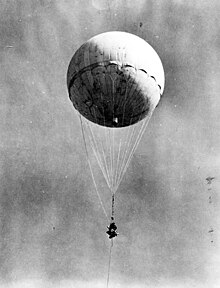| Fu-Go ふ号 | |
|---|---|
 Fu-Go balloon reinflated in California, January 1945 | |
| General information | |
| Type | Incendiary balloon |
| National origin | Japan |
| Manufacturer | Imperial Japanese Army (A-Type) Imperial Japanese Navy (B-Type) |
| Primary user | Imperial Japanese Army |
| Number built | About 9,300 |
| History | |
| Manufactured | 1944–1945 |
| Introduction date | November 3, 1944 |
| Retired | April 20, 1945 |
Fu-Go (ふ号[兵器], fugō [heiki], lit. "Code 'Fu' [Weapon]") was an incendiary balloon weapon (風船爆弾, fūsen bakudan, lit. "balloon bomb") deployed by Japan against the United States during World War II. It consisted of a hydrogen-filled paper balloon 33 feet (10 m) in diameter, with a payload of four 11-pound (5.0 kg) incendiary devices and one 33-pound (15 kg) high-explosive anti-personnel bomb. The uncontrolled balloons were carried over the Pacific Ocean from Japan to North America by fast, high-altitude air currents, today known as the jet stream, and used a sophisticated sandbag ballast system to maintain their altitude. The bombs were intended to ignite large-scale forest fires and spread panic.
Between November 1944 and April 1945, the Imperial Japanese Army launched about 9,300 balloons from sites on coastal Honshu, of which about 300 were found or observed in the U.S., Canada, and Mexico. The bombs were ineffective as fire starters due to damp seasonal conditions, with no forest fires being attributed to the offensive. A U.S. media censorship campaign prevented the Imperial Army from learning of the offensive's results. On May 5, 1945, six civilians were killed by one of the bombs near Bly, Oregon, becoming the war's only fatalities in the contiguous U.S. The Fu-Go balloon bomb was the first weapon system with intercontinental range, predating the intercontinental ballistic missile.